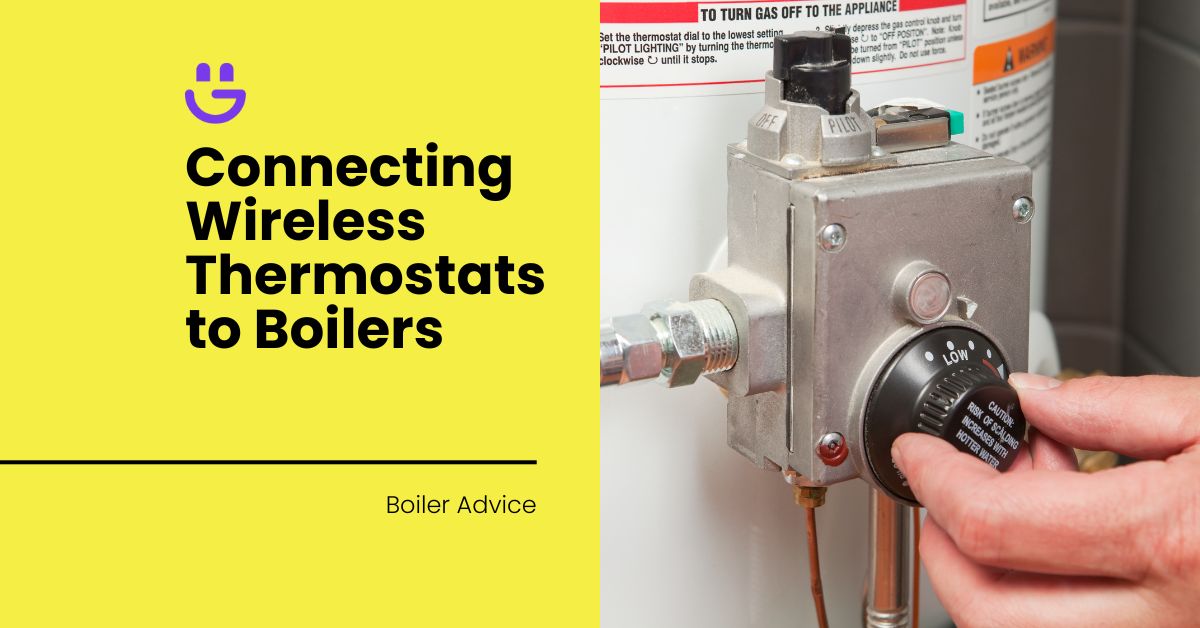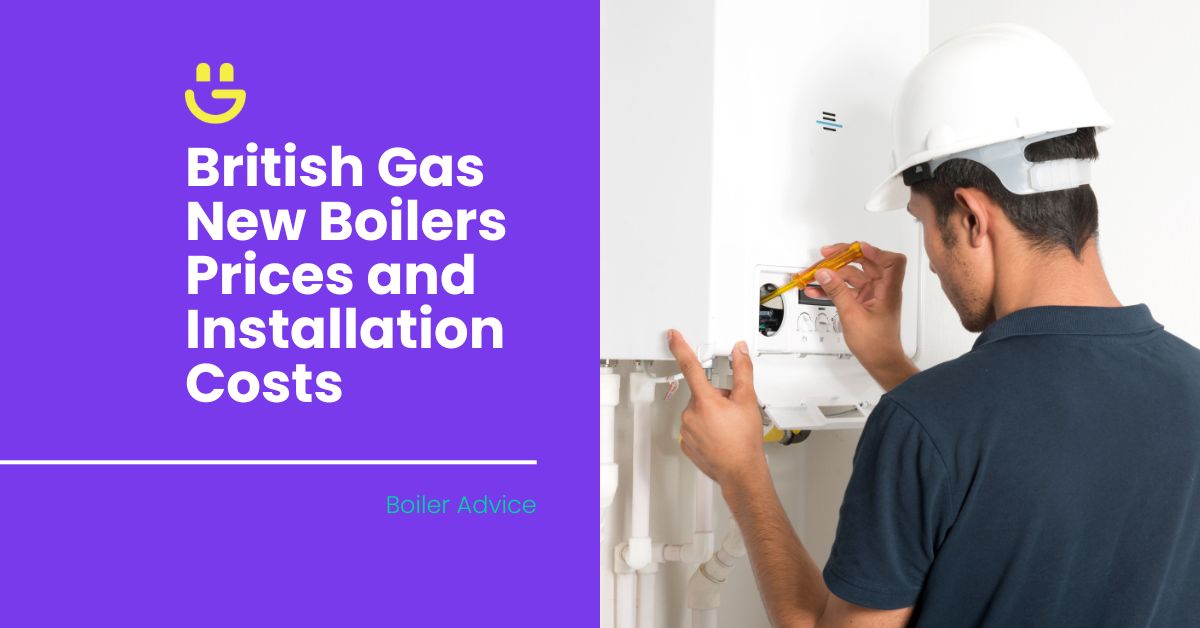Last Updated on November 14, 2025
In today’s smart home era, connecting a wireless thermostat to your boiler is vital. You can boost your comfort and energy efficiency by managing and monitoring your central heating system remotely.
Even with all the advantages, homeowners sometimes encounter problems when it comes to actually connecting these smart devices to their boilers. These obstacles include incompatibilities between various models and brands or trouble establishing a dependable connection.
This guide from Eco Happy will show you how to connect a wireless thermostat to a boiler. We’ll also look at how to fix typical problems that could come up in the process. Let’s take a closer look!
Contents
Understanding Wireless Thermostats
Wireless thermostats are devices that enable homeowners to remotely adjust the temperature of their central heating system. They eliminate the need for physical cabling and provide convenience and flexibility. Depending on your settings, you can control wireless thermostats anywhere in range with a smartphone or other suitable smart device.
You can connect a wireless thermostat to a boiler using Wi-Fi, radio frequency, or Bluetooth technology, which allows it to send signals to the boiler directly. They tell it to switch on or off depending on the intended temperature setting. This continuous communication between the thermostat and the boiler guarantees that the heating system runs smoothly.
Wireless thermostats are a popular choice among homeowners because they can operate heating systems without needing physical wires. Also, they can help save energy and lower utility bills by allowing you to change the temperature according to your preferences and schedule.
Want to know how to save on your electric bill? Read our guide for more tips.
Are all wireless thermostats smart?
Not every wireless thermostat falls into the “smart” thermostat category. But, all smart thermostats offer wireless operation. Most smart thermostats provide sophisticated features and capabilities beyond basic temperature adjustments.
Smart thermostats have integrated sensors, learning algorithms, and networking capabilities. They can detect when you’re home, learn your schedule, and change the temperature to maximise energy savings.
However, a wireless thermostat only provides wireless temperature control, without these sophisticated features.
Which wireless thermostat is suitable for my boiler?
Consider your particular boiler type when selecting a wireless thermostat for your boiler. Also, do a bit of research on how to set up a wireless or smart thermostat for your specific boiler system. Different boilers may need different thermostats.
Some popular brands that offer wireless thermostats for boilers include the following:
- Nest is renowned for its elegant styling and intuitive interface. They work with a variety of boiler types and include features like remote access via smartphone apps and learning capabilities.
- Honeywell is a trusted brand that provides wireless and smart thermostats with sophisticated programming choices and energy-saving features. Their smart thermostat has an excellent reputation for dependability and boiler system compatibility.
- Ecobee is a top producer of smart thermostats. They have sophisticated features, including room sensors for better temperature management and energy savings. Their thermostats are compatible with well-known smart home systems, enabling smooth automation and management.
You’re going to want to find the best smart thermostat for your home, with the most benefits and that meets your heating requirements.
When choosing a smart thermostat for your boiler, going with a reliable manufacturer is critical. Reputable manufacturers are known for their high standards of quality and dependability. You can be sure that your chosen product will be around for many years and fit your boiler well.
For best performance and boiler system compatibility, research features and read reviews. Then, select a wireless thermostat from a reputable company.
How to Connect a Wireless Thermostat to Your Boiler
Connecting a wireless thermostat to your boiler is a straightforward process. All you need do is follow a few simple steps. Let’s take a closer look!
Professional installation: Why it matters
It’s advised to have a professional install a smart thermostat and link it to your boiler. Although it may seem tempting to try installing this device yourself to save money, most modern boilers are complex systems and need specific training to operate correctly.
By hiring a professional, you can ensure the installation will be done correctly. You will feel more at ease, knowing that someone with the necessary knowledge and experience will handle any potential problems.
Also, expert installation often includes a warranty or guarantee. This protects your investment and ensures that future problems will be handled quickly.
Preliminary steps
Some preliminary steps you need to take before installation include:
- Check your system’s particular demands and specifications: Consider your boiler’s size, power supply, and infrastructural compatibility. This will assist in choosing the best installation strategy and equipment.
- Prepare the installation location: Remove any obstructions or blockages that might make things difficult for the installation. This involves making sure there is enough airflow and that it’s accessible for maintenance.
- Ask the expert installer any questions: Ask about your thermostat’s desired features or system integration to ensure that it suits your needs. Also, inquire about the required permissions or approvals, and wiring schematics. This will guarantee a seamless and well-structured installation procedure.
- Set a schedule for the installation procedure: Doing so will avoid interfering with your regular business activities and guarantee timely project completion.
It’s also important to consider elements like the distance from power sources and the intensity of the connection. This will help you gather an idea of a suitable location for the best coverage.
Thermostat placement guidelines
When installing a thermostat in your house, there are a few things to consider to guarantee maximum functioning and accuracy. The first and most crucial consideration is figuring out the best place for your thermostat. It’s a good idea to install the thermostat on an inside wall, away from direct heat or cold sources, such as windows, doors, or air vents.
This will eliminate misleading readings and temperature changes, which might reduce the overall efficiency of your HVAC system. Ensure you position the thermostat at a height that is easily accessible and at eye level for the typical person, making it easy to change the settings as needed.
Installation process
A skilled HVAC expert is usually responsible for thermostat installation. Here’s how the process will go:
- The technician will first switch off your HVAC system’s power at the circuit breaker to guarantee safety during the installation.
- They will remove the old thermostat from the wall, being careful not to damage any wires. The technician will prepare the wall by repairing any holes or gaps caused by the previous thermostat.
- They will securely attach the new thermostat, ensuring it is level and aligned.
- The technician will connect the wire from your HVAC system to the thermostat’s terminals, according to the manufacturer’s instructions.
- The HVAC system will be restarted and the technician will test the thermostat to verify it works properly.
Professional installation is essential to guarantee the system’s and its users’ security. Improper installation can cause hazards like electrical failures or unstable mounting, endangering those in your home. Hiring qualified experts with the know-how to install the system will minimise risks. It will also guarantee peak performance.
Troubleshooting common issues
When troubleshooting typical problems with your equipment, start by consulting the manufacturer’s handbook. The manual will include valuable details on how to fix common difficulties, such as connection problems. If you are experiencing connectivity issues, you can try the following strategies:
- Check for any interference: Check to see if there is any interference affecting the signal. This can apply to nearby electronic gadgets and real-world impediments, like furniture or walls.
- Adjust the location of your system: Try to reduce the impact by relocating or shifting any potential sources of interference away from your system. If this doesn’t work, you may need to have your thermostat moved.
- Review the settings on your system: You can also fix connectivity problems by reviewing your system’s settings and ensuring everything is set up. Also, check if you are connected to the correct Wi-Fi network. If this doesn’t work, you could also try resetting the thermostat.
If these DIY solutions do not resolve the problem, you may need professional help to diagnose and fix the issue further.
Benefits of Using Wireless Thermostats
Wireless thermostats have various benefits, making them a popular choice among homeowners.
Energy efficiency and cost savings
Wireless thermostats prevent needless heating or cooling of vacant spaces in your home and give you complete control over temperature settings in various zones. Over time, this may result in considerable energy savings.
Many wireless thermostats have features like remote access and customisable schedules. You can tailor your heating and cooling to your family’s daily activities and needs. This contributes to decreased energy use and utility costs and improves comfort.
Remote control and scheduling features
You can change the temperature from anywhere in the house or even while you’re away. This means you can guarantee that your home is cosy before you even arrive.
Wireless thermostats can help you conserve energy. They do this by altering the temperature while you’re not home or during sleeping hours. You can establish unique schedules for different days of the week. This helps optimise energy efficiency and removes the need to manually regulate the thermostat.
Better than traditional wired thermostats
Wireless thermostats don’t need complex wiring setups, in contrast to their wired counterparts. This makes installation simple. For households that lack the knowledge or finances to install a wired thermostat, this makes them a more practical choice.
There is more positioning freedom available with wireless thermostats. They are movable and provide ideal temperature control in every area of the house. This is especially useful for multi-story buildings or bigger residences. Different rooms could need different temperature settings.
FAQs
Can I fit a wireless thermostat to a Worcester boiler?
Yes, you can install a wireless thermostat in your Worcester boiler. However, you should check its compatibility and speak with a professional installer for optimal installation and configuration.
Will any wireless thermostat work with any receiver?
No, not every wireless thermostat works with every receiver. Before buying or installing a wireless thermostat, confirm it’s compatible with the specific receiver. Consulting with a skilled installer may help ensure a good fit and a smooth installation.
What is the range of the wireless signal for the thermostat and receiver?
The range of the wireless signal required for the thermostat and receiver to interact successfully varies based on the building’s structure and any potential interference. Refer to the manufacturer’s specs to discover the effective range. Additionally, contact a professional installer who can examine the surroundings and advise on establishing an ideal communication range.
Final Thoughts
When you connect a wireless thermostat to a boiler, you reap several advantages and conveniences. It provides a simple and convenient way to manage the temperature in various areas of your home and promotes energy efficiency and cost savings. Homeowners can also remotely check and change thermostat settings, allowing you to stay comfortable and save energy.
A wireless thermostat is flexible and adaptable, working with various boiler types. It will improve your comfort and save you money in the long term.
Do you need help connecting your wireless thermostat to your boiler? Contact Eco Happy to schedule an appointment with one of our experienced technicians.






Tom Allen
Solar Expert